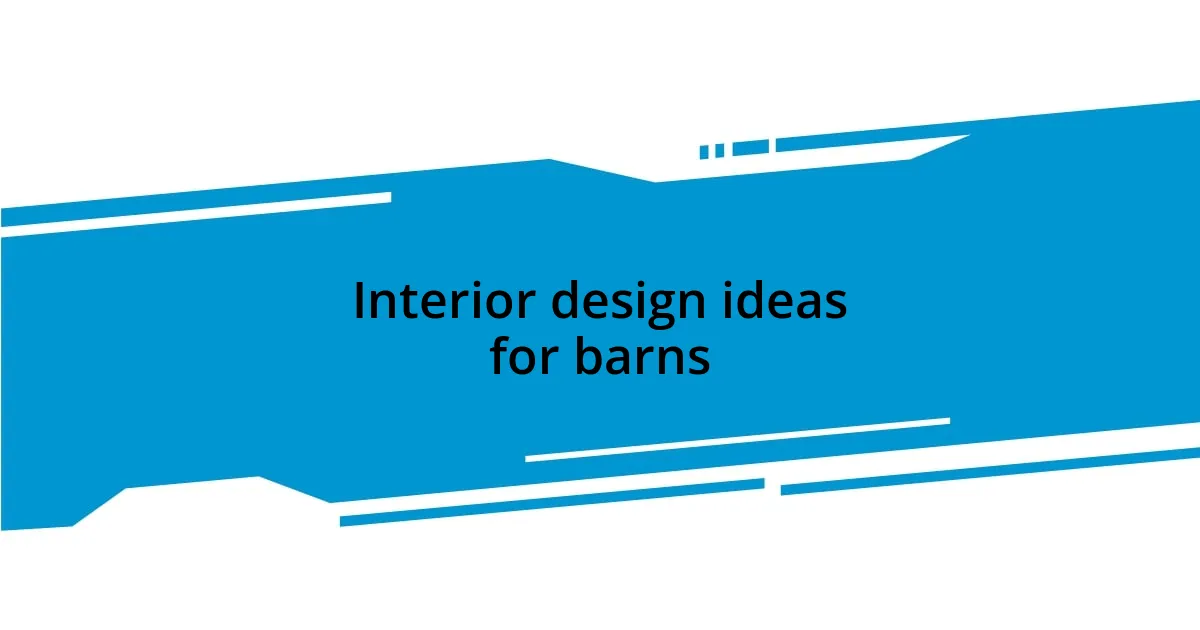Key takeaways:
- A converted barn merges rustic charm with modern living, preserving historical features while offering modern amenities.
- Unique architectural elements, such as timber framing, barn doors, and open layouts foster a warm, inviting atmosphere and a sense of community.
- Practical considerations for purchasing include structural integrity, location, and understanding zoning laws and renovation restrictions.
- Emphasizing thoughtful planning, the right materials, and effective lighting greatly enhance the conversion project and overall living experience.

What is a converted barn
A converted barn is essentially a traditional agricultural structure transformed into a livable space, blending rustic charm with modern functionality. I still remember my first experience in a converted barn; the blend of exposed wooden beams and large, airy windows was exhilarating. It felt like stepping into a storybook, where each nook and cranny whispered tales from its past.
These spaces often retain their historical features while being redesigned to accommodate contemporary living, such as open floor plans and updated amenities. I often wonder, how do people decide which original elements to keep? Personally, I’ve found that preserving those unique features—like a weathered barn door or a stone fireplace—adds character and soul to the home.
Living in a converted barn can feel like embracing a piece of history while enjoying all the comforts of modernity. It’s that juxtaposition that captivates me; the spirited charm of yesteryear coupled with today’s design sensibilities. Doesn’t that sound like the perfect blend for those seeking inspiration in their living spaces?

Reasons to love converted barns
There’s something truly magical about converted barns that resonates on multiple levels. The expansive interiors, filled with natural light, create a welcoming atmosphere. I recall wandering through a friend’s converted barn, just marveling at how the high ceilings made the space feel both grand and intimate at the same time, a rare combination that I find deeply comforting.
Here are some reasons to love these unique homes:
- Character and History: Each barn has its own story, and living in one means becoming a part of that narrative.
- Unique Architecture: The charming features like vaulted ceilings and exposed beams can’t be replicated in new builds.
- Natural Materials: Barns often showcase beautiful woodwork and stone, evoking a sense of warmth and coziness.
- Open Layouts: The spacious designs encourage creativity, allowing for personalized interior decorations and arrangements.
- Connection to Nature: Many barns are situated in idyllic rural settings, offering breathtaking views and peace away from the city hustle.
Stepping inside a converted barn often feels like entering a serene sanctuary, where the outside world’s noise fades away. I remember one particularly brisk autumn evening, sitting by the fireplace of a converted barn, wrapped in a cozy blanket, while the leaves danced outside. Those moments solidify my belief that these spaces aren’t just homes; they are a source of inspiration and tranquility.

Unique architectural features of barns
Barns are built to last, and their architectural features often showcase this durability. One standout aspect I adore is the use of timber framing. It creates a sense of strength and stability, and when I stand beneath those massive beams, I can’t help but feel grounded. The craftsmanship tells a story—often dating back to when it was constructed. It’s as if the barn itself is a living testament to the hands that built it.
Additionally, let’s not overlook the iconic barn doors. These large, sliding doors not only serve a practical purpose but also add an undeniable charm to the exterior. I once visited a friend’s converted barn that featured an enormous reclaimed barn door, which when opened, revealed a stunning view of rolling hills. I still remember how it felt to step through that threshold into nature’s embrace. Those doors frame the essence of barn living, blurring the lines between indoors and outdoors in a way that makes each moment feel special.
Lastly, the layouts of barns are often dictated by their original function, resulting in open spaces that naturally flow into one another. This layout encourages a sense of community within the home. I fondly think back to hosting dinner parties in a friend’s lofted kitchen area, where laughter echoed among the beams. It became an evening of shared memories as everyone gathered around a big farmhouse table. Who knew a barn could gather friends in such a meaningful way?
| Architectural Feature | Details |
|---|---|
| Timber Framing | Provides strength and a sense of history, showcasing craftsmanship from the original construction. |
| Barn Doors | Large, sliding doors that add charm and connect the indoors with the outdoors beautifully. |
| Open Layouts | Flowing design that fosters connection, making spaces feel communal and inviting for gatherings. |

Interior design ideas for barns
When it comes to interior design in a converted barn, I find that embracing the rustic charm is key. Think about utilizing reclaimed wood for flooring or furniture; it brings character and is a nod to the barn’s past. I remember a time when my friend curated an entire living area with refurbished barn wood, and it not only felt cozy but also told a story of its previous life. How often can you say your furniture has history?
Incorporating a modern twist can elevate the design while maintaining that warm, inviting atmosphere. Consider mixing contemporary pieces with the barn’s original elements. For instance, pairing sleek, metal fixtures with exposed beams creates a striking contrast. When I visited a beautifully designed barn last summer, the homeowners embraced this approach. Their choice of minimalist furniture alongside ornate, traditional lighting transformed the space into a delightful blend of old and new.
The color palette in barns also plays a pivotal role. I think soft, earthy tones can enhance the natural light that often floods these spaces. One memorable evening, gazing at the muted greens and soft whites in my neighbor’s barn-inspired interior, I felt strangely at peace. Have you ever noticed how certain colors can evoke emotions? It’s as if the hues wrap around you like a warm embrace, making every moment spent there more special.

Outdoor spaces and landscaping
Outdoor spaces in a converted barn often present a canvas of rustic beauty. I recall one evening spent outside a friend’s barn, where we gathered around a fire pit surrounded by vibrant wildflowers. The setting sun cast a warm glow, and I felt a deep connection to nature. Isn’t there something magical about being outdoors, especially in a space that merges the natural and the cultivated?
Landscaping complements the barn’s character beautifully. I once helped plant a small herb garden in a converted barn’s sideyard, and it transformed the outdoor space. The fresh scents of basil and rosemary filled the air, bringing life to what could have been just a patch of dirt. I believe that adding plants not only enhances the aesthetic but also imbues a sense of vibrancy and joy.
Additionally, I appreciate how outdoor seating areas can become gathering spots. There’s a charm in arranging a few rustic wooden chairs around a simple table, creating an inviting space for coffee or casual meals. I remember sipping tea on a sunny afternoon at a barn retreat, the laughter of friends blending with the soft rustle of leaves. Do you think outdoor moments like these make lasting memories? For me, they certainly do, as they turn mere spaces into experiences that linger in our minds long after we’ve left them.

Practical considerations when buying
When considering a converted barn, I find it crucial to evaluate the structural integrity. Older buildings can harbor hidden issues, such as outdated wiring or compromised supports, which may require more investment than anticipated. I once toured a stunning barn only to discover later that it needed extensive foundation work, turning what felt like a dream into a daunting financial prospect.
Another practical consideration is the location. I really believe that the setting of your barn is just as important as its aesthetic. A friend of mine purchased a barn tucked away in the countryside, and while the seclusion was idyllic, the long drive to amenities quickly became a headache. Have you thought about how daily life will play out in such a space? Choosing a barn that balances tranquility with convenience can significantly enhance your overall living experience.
Lastly, zoning laws and renovation restrictions can impact your vision. I was surprised to learn that some barn conversions face challenges like maintaining original features or complying with preservation guidelines. Navigating these legalities was frustrating for a colleague of mine, who had to revise his plans multiple times. It’s vital to explore these regulations beforehand to ensure your dream space doesn’t unwittingly become a source of stress.

Tips for converting a barn
Converting a barn can be an exciting venture, but diving into the renovation requires thoughtful planning. I remember when I embarked on my own barn project; I made a detailed list of essentials early on. Setting a clear budget, planning for both visible and hidden costs, like insulation and plumbing, can save you from unexpected surprises. Have you ever faced a financial hiccup during a renovation? Trust me, it’s a lesson you only want to learn once!
Choosing the right materials plays a significant role in achieving that perfect blend of rustic charm and modern comfort. During my last project, I opted for reclaimed wood for the flooring, which not only looked stunning but also had a history of its own. The warmth and character it brought to the space were undeniable. Plus, I was helping the environment by using sustainable resources. Wouldn’t you agree that every element in your home should reflect both aesthetic and ethics?
Finally, do not underestimate the importance of lighting in a barn. I remember being enchanted by the way the afternoon sun streamed through the barn’s large windows, casting beautiful patterns on the floor. By strategically placing light fixtures that complement the original beams, you can create a cozy yet vibrant atmosphere. Isn’t it amazing how lighting can transform a space? It turned my converted barn into a warm haven I never wanted to leave, inviting friends over just to experience that glow.














